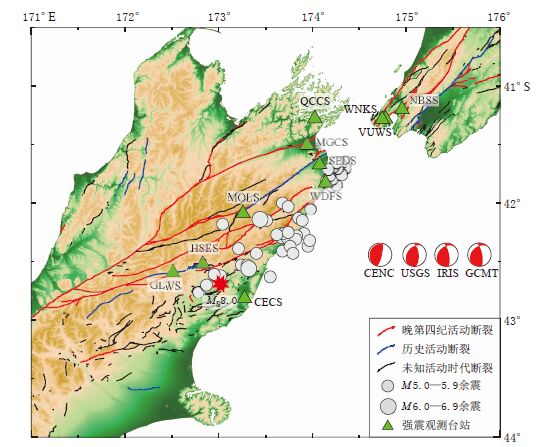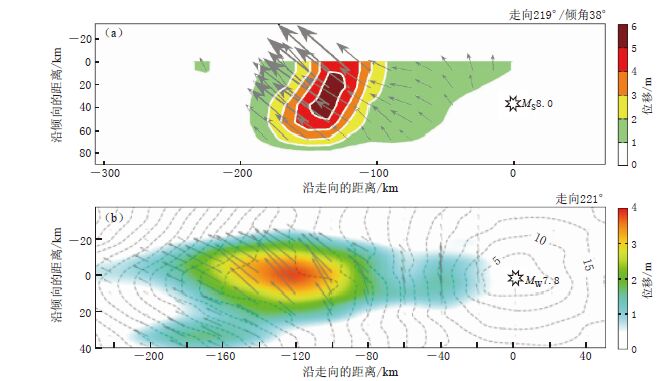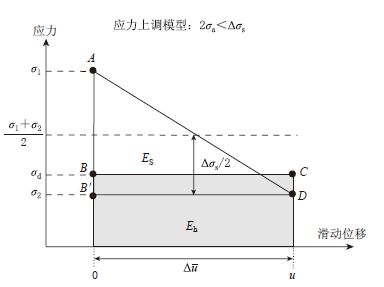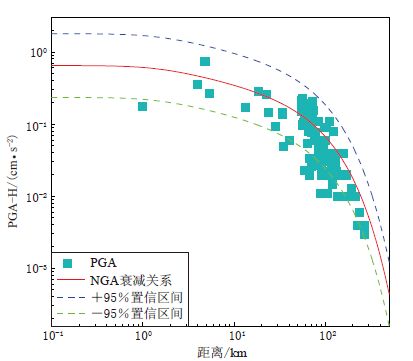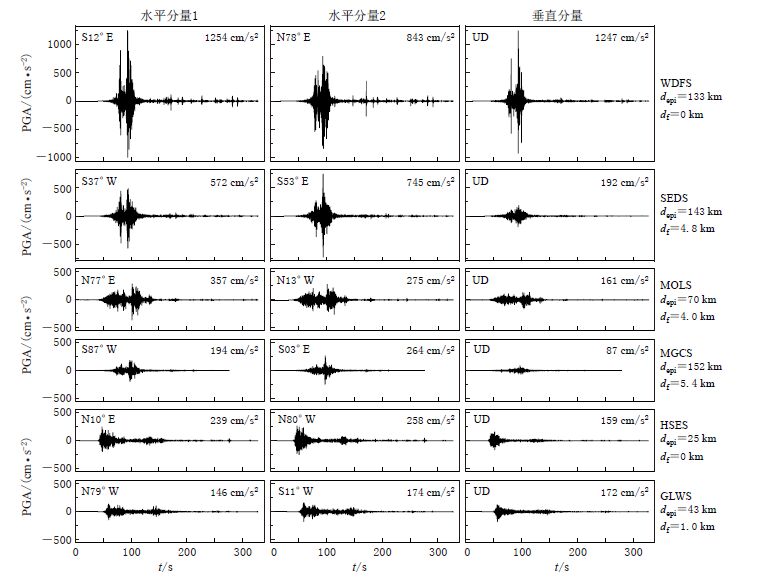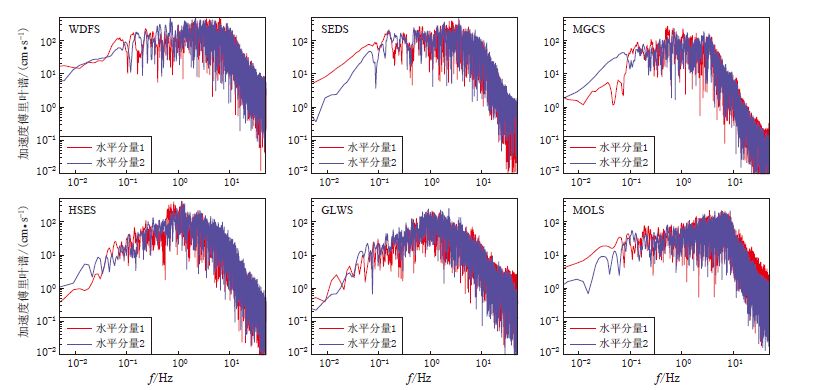Source parameters of the 2016 MS8.0 New Zealand earthquake and characteristics of strong ground motion observations
-
摘要: 2016年11月13日新西兰发生MS8.0地震,该地震造成2人死亡,20多人受伤,仅10余栋房屋严重受损,致灾特征较轻. 本文针对新西兰MS8.0地震的震源参数特征,对该地震的震源过程进行了分析. 结果表明,该地震的地震波辐射能量和视应力均偏低,震源破裂过程为应力上调模式,发震断层破裂相对充分,余震相对丰富.结合新一代衰减关系(NGA)的分析结果显示,该地震的强地面运动峰值加速度(PGA)观测记录整体偏低,与基于震源参数对该地震PGA的理论估算结果较为一致. 进一步选取10 km范围内6个台站的强震观测记录进行比较研究,初步认为影响该地震近断层区域PGA高值的因素主要是断层破裂面上最大滑动集中区的位置,而非主震的初始破裂位置. 综合研究表明,新西兰MS8.0地震的强地面运动主要受到应力上调模式和最大滑动集中区位置的影响,致灾特征较轻则可能源于峰值加速度偏低和地表破坏较大地区的人口相对稀少.Abstract: The New Zealand earthquake of November 13, 2016, MS8.0 occurred near the Kaikoura area in the South Island, New Zealand, with focal depth of 11 km. The MS8.0 earthquake occurred on the transform boundary faults between the Pacific Plate and the Australian Plate, and the focal mechanism solution shows the earthquake is of thrust type event. Two people were killed, twenty or so people were injured and more than ten buildings were destroyed during this earthquake, so the damage level is not so severe in consideration about the huge magnitude. In this study, we analyzed the dynamic source process according to the source parameters, it can be confirmed that the radiated energy and the apparent stress of the New Zealand earthquake are small and minor. The results indicate a frictional overshoot behavior in the dynamic source process of the earthquake, which is actually with sufficient rupture and more abundant moderate aftershocks. Comparison with the next generation attenuation (NGA) relationship indicates that the observed horizontal peak ground acceleration (PGA) of the strong ground motion is generally small. The ground motion observations show that the recordings of New Zealand MS8.0 earthquake are less than the New Zealand MW6.1 earthquake in 2011 with nearly 200 deaths. In addition, we studied the characteristics of the observed PGAs at the six near-fault stations, which are located in the area less than 10 km to the main fault. The relatively high ground motion of the six stations may be produced by the higher slip around the asperity area rather than the initial rupture position on the main plane. In fact, the less damage level of New Zealand MS8.0 earthquake may probably result from the smaller strong ground motion and the rare population in the near fault area, with the most severe surface destruction.
-
引言
浙江珊溪水库位于浙江省温州市飞云江干流上游河段,水库绝对坝高为156.8 m,坝长为308 m,设计最高库容为18.24亿m3,最高水位为154.75 m.该水库于2000年5月12日开始蓄水.自2002年7月28日ML3.5地震发生后,库区地震活动变得频繁(钟羽云等,2011).截至2014年12月31日,珊溪水库共记录到8000多次地震,其中ML≥4.0地震21次,最大地震为2006年2月9日ML4.6地震.库区地震以震群序列活动为主,2006年和2014年曾发生过两次明显的震群序列活动,其它时间相对平静,两次震群均无明显主震,属典型水库诱发地震.前人对2006年震群序列的发震构造、震源机制及波速特性等开展了较多研究:朱新运等(2010)对珊溪水库2006年震群进行了重新定位,并利用P波初动计算了断层面解,讨论了该震群的发震构造;邹振轩等(2010)对水库地震的S波分裂进行了研究,认为库区应力场稳定,应力调整已结束,未来发生强余震的可能性较小;钟羽云等(2011)通过震源位置和速度结构联合反演拟合得到了2006年震群的发震断层面参数,之后利用P波初动法求解了ML≥4.0地震的震源机制解,并结合库区断层活动特性和宏观调查资料,得出珊溪水库地震序列是双溪—焦溪垟断裂右旋走滑的主破裂与南浦—焦溪垟断裂、东坑—章坑断裂、岩上断裂等多个次要破裂共同作用的结果;张帆等(2013)利用P波初动和直达P,S波最大速度振幅比联合求解小震震源机制的方法,得到2006年震群震源机制的主压应力为NS向,主张应力为EW向,应力方向以水平为主,发震断层倾角较大且多为走滑断层;钟羽云等(2015)研究了珊溪水库地震的波速比时空分布特征,认为位于水库淹没区的双溪—焦溪垟断裂西北段的波速比较小,位于水库库岸的双溪—焦溪垟断裂东南段在深度方向上存在两个波速比高、低值相间的区域.为了进一步研究后续震群的发震特征及水库发震趋势,本文拟使用双差地震定位法对2014年9—12月发生的震群序列进行重新定位,并利用Zhu和Helmberger(1996)发展的CAP(cut and paste)方法根据ML≥3.0地震事件的波形数据反演震源机制解,在此基础上进一步研究珊溪水库地震的发震机理,结合水库水位变化和震级-时间关系,对珊溪水库地震的时间序列特征进行分析.
1. 库区地质构造概况
珊溪水库位于浙东南褶皱带内温州—临海坳陷带的南部,即泰顺—温州断坳,库区出露主要为燕山期火山碎屑岩及花岗岩和闪长岩侵入体.新近纪以来库区新构造运动主要表现为大面积间歇性升降运动,以整体性抬升为主,断裂两侧活动差异不明显,地热与地震活动弱.由于库区地块大面积间歇性的强烈上升,形成了构造-侵蚀中低山地抬升区.河流侵蚀作用强烈,河谷深切,多峡谷,并发育四级河流阶地和五级剥夷面.第四纪地层主要由冲洪积砂砾石、细粉砂层组成,厚度仅几米至十余米.
珊溪水库库区内主要有14条规模不大的断裂,长度均在10—25 km之间,多为深度在5 km之内、走向以NE和NW向为主的陡倾角逆冲盖层断裂,且现今活动性不明确(钟羽云等,2011). 2014年震群主要呈NW向分布在双溪—焦溪垟断裂南侧(图 1),该断裂西北起自云湖双溪村,经涂山、塘垄、东龙,终止于珊溪镇焦溪垟村,全长约20 km,总体走向为NW,倾向为SW,倾角约为80°.该断裂在卫星影像上线性特征明显,断层所过位置表现为沟谷和垭口地貌特征.钟羽云等(2010, 2011)通过对2006年震群序列重新定位并对震源机制进行研究后认为,该断裂为震群活动的发震构造,呈右旋走滑活动性质.
![]() 图 1 2006年和2014年震群台网定位震中分布及库区断层分布图F1:双溪—焦溪垟断裂;F2:百丈坑—蝉头断裂;F3:百丈口—排前断裂;F4:洪口—章坑断裂;F5:江口—汇溪断裂;F6:南浦—焦溪垟断裂; F7:东坑—章坑断裂;F8:岩上断裂Figure 1. Epicenter distribution of the 2006 and 2014 earthquake swarms and the faults in Shanxi reservoir regionF1: Shuangxi-Jiaoxiyang fault; F2: Baizhangkeng-Chantou fault; F3: Baizhangkou-Paiqian fault; F4: Hongkou-Zhangkeng fault; F5: Jiangkou-Huixi fault; F6: Nanpu-Jiaoxiyang fault; F7: Dongkeng-Zhangkeng fault; F8: Yanshang fault
图 1 2006年和2014年震群台网定位震中分布及库区断层分布图F1:双溪—焦溪垟断裂;F2:百丈坑—蝉头断裂;F3:百丈口—排前断裂;F4:洪口—章坑断裂;F5:江口—汇溪断裂;F6:南浦—焦溪垟断裂; F7:东坑—章坑断裂;F8:岩上断裂Figure 1. Epicenter distribution of the 2006 and 2014 earthquake swarms and the faults in Shanxi reservoir regionF1: Shuangxi-Jiaoxiyang fault; F2: Baizhangkeng-Chantou fault; F3: Baizhangkou-Paiqian fault; F4: Hongkou-Zhangkeng fault; F5: Jiangkou-Huixi fault; F6: Nanpu-Jiaoxiyang fault; F7: Dongkeng-Zhangkeng fault; F8: Yanshang fault2. 地震重定位
珊溪水库2014年震群始于9月12日,截至12月30日共发生4266次地震,最大地震为10月25日ML4.4地震.本文使用双差定位法(Waldhauser,Ellsworth, 2000)重新定位了具有8个及以上震相记录的地震,共获得4184次地震重定位的震中数据(图 2).地震重定位使用了25个台站,震中距均为100 km以内,其中8个台站为震中距小于20 km的近台(图 1).由于有近台控制,定位精度较高,定位残差由重新定位前的0.11 s下降至0.02 s,水平向定位误差为9 m, 垂直向定位误差为12.6 m.记录到的最小地震震级为ML0,由最大似然法估计的完整起始震级为ML0.3.
2014年震群经过重新定位后,其震中位置呈NW向线性条带分布在双溪—焦溪垟断裂南侧,地震条带长约10 km, 宽约0.6 km.图 3a,b分别为沿着及垂直于线性条带方向所作的震源剖面,可见,震源深度主要分布在0.7—6 km之间,最大深度接近8 km,与华南地区多数构造地震0—20 km的震源深度分布相比明显偏小,亦与钟羽云等(2010, 2011)对2006年震群重新定位得到的最大9.5 km、平均5.4 km的震源深度相比要浅.
由沿线性条带方向所作的震源剖面AB(图 3a)可见,地震活动分层现象明显,大致在4.5—5 km之间明显缺震.地震活动是由库水渗入断层形成的破裂面增加了孔隙压而产生,这种地震分布样式说明双溪—焦溪垟断裂形成的破裂面在垂向上高度不均匀且不连续.库区断裂发育在上侏罗统火山岩及下白垩统火山沉积岩地层中(钟羽云等,2011),说明地下物质是由不同力学性质的岩层组成,岩性强度不同决定了变形特性不同,从而导致了地震分布的集中或缺失.沉积岩中可能存在柔性较大的岩层,柔性岩层不易产生脆性破裂,而会起到力学障碍体的作用,阻止流体的扩散(Roche,Baan,2015),从而导致该层无地震发生,出现缺震现象.垂直线性条带的震源剖面刻画出高角度倾向SW的结构面(图 3b).
3. 震源机制解反演
本文使用CAP方法计算震源机制解.该方法是一种全波形反演方法,对速度模型及介质的横向不均匀性依赖度较低(Zhao,Helmberger,1994;Zhu,Helmberger,1996), 反演时将宽频带地震记录分为体波和面波两部分进行反演,并允许两者相对浮动, 并在适当的时间变化范围内,搜索出合成地震图与观测地震图全局差异最小的震源机制解.本文选取浙江省地震监测预报研究中心记录的2014年9—10月ML≥3.0地震事件进行分析,并从中挑选出震相清晰、对震中包围较好、信噪比较高的32次地震进行反演.
采用Crust2.0双层地壳速度结构模型进行震源机制解反演,该模型将0—33 km的地壳分为两层(表 1).
表 1 Crust2.0地壳速度模型Table 1. The Crust2.0 velocity model层厚
/kmvP
/(km·s-1)vS
/(km·s-1)介质密度
/(g·cm-3)21 6.01 3.5 2.75 12 6.88 3.6 2.80 0(莫霍面) 7.98 4.6 3.35 CAP方法将观测波形分解为5部分,通过移动每部分的波形,分别与理论(合成)地震图进行拟合,使二者吻合得最好.在移动波形时产生了偏移时差,地壳速度模型是影响偏移时差的主要因素.图 4为理论波形与观测波形的相似性对比图,图中仅给出最大事件,即2014年10月25日ML4.4地震的反演结果.图 4中除少数台站的偏移时间差和P波实际到时与理论到时差稍大以外,大部分台站的时间差很小,说明选取的速度模型符合实际情况.理论波形与观测波形的相似性是判断反演结果是否可靠的依据之一.此次地震震源机制反演所选用8个台站的记录中,P波拟合相关系数大于0.6的地震波形记录占81%,面波拟合相关系数大于0.8的地震波形记录占92%,说明反演得到的震源机制解是可靠的.
![]() 图 4 2014年10月25日ML4.4地震观测波形图(黑色)与理论地震图(红色)的比较台站名下方两个数字分别表示震中距(单位:km)和P波实际到时与理论到时差(单位:s), 波形下方第一行数值为观测值与理论到时差(单位:s), 第二行数值为二者的相关系数Figure 4. The comparison between the observed waveforms (black) and the synthetic seismograms (red) of the ML4.4 earthquake occurred on October 25, 2014The station codes are given at the left of the waveforms with epicentral distance (in km) and the difference of the P wave arrival times between observed and calculated values (in s) below. The first line below the waveform is the difference of the arrival times between observed and calculated values (in s), and the second line is the correlation coefficient between the previous two
图 4 2014年10月25日ML4.4地震观测波形图(黑色)与理论地震图(红色)的比较台站名下方两个数字分别表示震中距(单位:km)和P波实际到时与理论到时差(单位:s), 波形下方第一行数值为观测值与理论到时差(单位:s), 第二行数值为二者的相关系数Figure 4. The comparison between the observed waveforms (black) and the synthetic seismograms (red) of the ML4.4 earthquake occurred on October 25, 2014The station codes are given at the left of the waveforms with epicentral distance (in km) and the difference of the P wave arrival times between observed and calculated values (in s) below. The first line below the waveform is the difference of the arrival times between observed and calculated values (in s), and the second line is the correlation coefficient between the previous two判断反演结果是否可靠的另一个依据是最优深度拟合误差.反演结果显示32次地震中有11次事件的拟合误差均小于或等于0.6%.本文仅从反演结果中选取两次地震的拟合误差随深度的变化关系进行展示(图 5).图中拟合误差曲线光滑,最小误差附近的震源机制解变化很小,说明深度反演结果稳定可靠.经相似度筛选得到11次地震事件中有10次事件的反演深度小于5 km,深度最大的事件为10月26日的ML3.3地震,其深度为9.8 km.综上本文的反演深度与精定位深度基本一致.
利用CAP法对珊溪水库32次ML≥3.0地震事件进行反演,得到最佳深度处的震源机制解,从中挑选地震波形记录中观测波形与理论地震图拟合相关系数大于0.6占80%以上的11次事件(图 6),其反演结果列于表 2.
表 2 珊溪水库2014年震群11次ML≥3.0地震震源机制解Table 2. The focal mechanisms of eleven ML≥3.0 earthquakes in the 2014 earthquake swarm of Shanxi reservoir发震时刻 ML 节面Ⅰ 节面Ⅱ P轴 T轴 B轴 月-日 时:分 走向
/°倾角
/°滑动角
/°走向
/°倾角
/°滑动角
/°方位角
/°倾角
/°方位角
/°倾角
/°方位角
/°倾角
/°09-17 20:47 3.5 308.7 72.1 172.6 41.0 83.0 1.0 173.9 7.5 266.1 17.7 61.6 70.7 09-23 13:20 4.2 311.0 81.0 173.0 42.1 83.1 9.1 176.4 1.5 266.7 11.3 79.1 78.6 09-23 17:40 3.7 309.2 83.2 164.9 41.0 75.0 7.0 355.8 5.7 264.3 15.5 105.5 73.5 09-27 08:30 4.1 38.0 83.0 10.0 306.8 80.1 172.9 172.2 2.1 262.6 12.0 72.7 77.8 09-27 08:41 3.5 119.0 60.0 150.0 225.1 64.3 33.7 351.2 2.7 83.6 41.3 258.1 48.6 10-03 11:42 4.0 311.0 71.0 174.0 43.0 84.3 19.1 175.7 9.2 268.5 17.5 58.9 70.1 10-15 15:49 4.0 39.0 83.0 -1.0 129.1 89.0 -173.0 354.3 5.7 263.9 4.2 137.2 82.9 10-25 18:42 4.4 311.0 81.0 -21.0 44.4 69.3 -170.4 266.1 21.5 359.2 8.0 108.8 67.2 10-25 19:29 3.8 310.0 81.0 172.0 41.3 82.1 9.1 175.6 7.1 265.7 12.0 81.9 78.0 10-26 07:03 3.4 118.0 77.0 163.0 211.9 73.4 13.6 165.4 2.4 74.5 21.1 261.7 68.7 10-30 19:25 3.3 130.0 63.0 161.0 228.9 73.1 28.3 357.7 6.7 91.8 31.7 257.2 57.4 由表 2可知,11次事件的震源机制解比较相似,均为走滑型地震,震中均位于双溪—焦溪垟断裂附近(图 6),这些震源机制解均有一个与该断裂走向一致的NW向节面,该节面倾角较陡,近直立,为右旋走滑错动性质,为地震活动的破裂面.
4. 珊溪水库震群与水库水位的关系
据中国地震台网中心提供的地震目录,2000年以前珊溪水库库区鲜有地震发生.珊溪水库于2000年5月下闸蓄水,库区地震活动始于2002年7月28日的一次ML3.5地震,此后每年均有地震活动,并表现出一定的时间特征(图 7).
从时间序列上看,珊溪水库库区大约每隔4年发生一次震群型地震,即2002,2006,2010,2014年均发生震群活动,其中2006年和2014年的震群序列震级较大,地震频度较高,且2014年震群活动频次明显升高,地震活动有随时间不断加强的趋势.研究表明,长期持续的高水位可诱发地震能量的集中释放,这在广东新丰江水库(华卫等,2012)、湖北丹江口水库(Liu et al, 2011)及陕西石泉水库(陈希圣,1993)等均可观察到类似现象, 而且水库水位的上升或者下降会诱发地震(陈希圣,1993;程惠红等,2013).珊溪水库在2006年ML4.6地震发生前数月,水位降幅约21 m;在2010年震群发生前,水位涨幅约13 m左右;2011年以后水库水位较高且变化平稳;2014年震群发生前水位并无明显变化.总体上,珊溪水库的水位变化与震群活动的关系不明显,震群活动可能是由库水向库底断层破裂面长期渗透扩散使孔隙压增加所致.
5. 震群序列活动与断裂构造关系
震群活动是指没有明显主震事件的地震序列(Lay,Wallace, 1995),在水库、火山及地热活动区发生的震群活动被认为是由地下流体的流动所诱发的(Johnson,McEvilly, 1995; Noir et al, 1997; Audin et al, 2002; Saccorotti et al, 2002; Parotidis et al, 2003; Yukutake et al, 2008).根据地震活动特征分析,珊溪水库诱发地震大致存在4年一次的爆发规律,未来依然存在发生震群活动的条件. 2006年和2014年两次震群序列的重新定位结果显示震中均呈线性条带平行分布在双溪—焦溪垟断裂南侧,2014年震群序列发生在2006年震群的NW向延伸的方向上(钟羽云等,2011),两次震群的地震分布连成一条地震条带,在构造图上该条带并未沿已知的NW向双溪—焦溪垟断裂分布,而是分布在其南侧,这可能是由于断裂的研究程度不高,其定位误差较大所导致.一般认为由地下流体引发的震群活动主要沿先存断裂的破裂面活动(Hill, 1977; Sibson, 1987, 1996).由震源机制解结果可知,NW向节面的错动性质呈右旋走滑型,与钟羽云等(2011)所得的2006年震群震源机制解的结果一致,说明两次地震序列可能均为沿NW向双溪—焦溪垟断裂活动的结果, 且地震活动出现沿断裂向西迁移的现象.钟羽云等(2010)认为双溪—焦溪垟断裂为2006年珊溪水库震群的发震构造,即该震群为断裂活动所产生的构造地震.虽然震群活动可能沿双溪—焦溪垟断裂分布,并刻画出了断裂结构面特征及活动性质,但由于没有明显的主震且其震源深度较浅,迄今震群活动并非是断裂活动所导致的结果,仍然是水库诱发地震活动,即断裂产生的破裂面为库水的流动提供了通道,由孔隙压的增加引发了震群活动.未来水库地震活动有激发该断裂活动的可能,而一旦该断裂活动被激发,则有发生构造地震的可能,因此该断裂被激发的条件和现今活动性及未来发生地震的危险性均值得重视,需要进一步深入研究.
6. 讨论与结论
本文通过对珊溪水库2014年9—12月发生的震群序列的重新定位和ML≥3.0地震事件的震源机制解反演,以及对水库水位与地震发生关系的分析,获得了以下结论与认识:
1) 重新定位的珊溪水库2014年震群序列的震源主要在0.7—6 km深度范围内分层分布,在4.5—5 km之间明显缺震. 2014年震群序列分布在2006年震群NW向延伸的方向上,两者构成的同一条地震线性条带极可能分布在双溪—焦溪垟断裂上,震群活动呈现沿断裂向NW迁移的现象.精定位震源分布刻画出双溪—焦溪垟断裂结构面以高角度倾向SW,且在垂向上高度不均匀和不连续,呈右旋走滑活动性质.由于没有明显的主震且多数地震震源深度在6 km以上,因此震群活动仍然属于水库诱发地震,双溪—焦溪垟断裂不是震群序列的发震构造,但其未来有被激发发生构造地震,即破坏性地震的可能.
2) 珊溪水库库区蓄水前鲜有地震发生,说明该水库地震属于水库诱发型地震, 发震周期大约为4年,属震群型地震,水库水位变化与震群活动关系不明显,震群活动可能是由库水沿断层破裂面长期渗透扩散引起孔隙压的增加所致.从发震震级和频度看,地震活动有随时间逐步增强的趋势,断裂被激发发生构造地震的条件及未来发生地震的危险性值得进一步深入研究.
3) 从发震震级和频度看,地震活动有随时间逐步增强的趋势,但这只是一种定性的推测,本文尚未定量估计出震群活动的频度及未来最大震级,同时双溪—焦溪垟断裂被激发发生构造地震即破坏性地震的条件等问题将是下一步研究的重点.
4) 本文所使用的双差定位方法具有较高的定位精度,能细致地刻画发震断层的空间形态,但定位时用到的地震目录所提供的震相、走时存在一定的人为误差,未来可利用波形互相关技术减小人为因素的影响,进一步提高定位精度.另外利用层析成像技术可反演出库区的地下速度结构,对比不同蓄水时期地下速度结构的变化,对于理解水库向地下渗水的过程与地震之间的关系具有十分重要的意义.
-
图 2 新西兰MS8.0地震主震发震断层面上的滑动位移分布图
图(a)引自中国地震局地球物理研究所(2016),图(b)引自USGS(2016)
Figure 2. Cross-section of slip distribution on the main fault for the MS8.0 New Zealand earthquake
Fig.(a)refers to Institute of Geophysics,China Earthquake Administration(2016),and Fig.(b)refers to USGS(2016). The strike direction is indicated above each fault plane and the hypocenter location is denoted by a star
图 3 断层动态破裂过程中应力上调模式示意图(修改自Savage,Wood,1971)
σ1和σ2分别为初始应力和最终应力,σd为动态应力,u为位移,Δū为断层面上平均滑动位移,Eh为摩擦热能,即为图中所示灰色矩形块面积
Figure 3. Overshoot model during the dynamic rupture process of seismogenic fault revised from Savage and Wood(1971)
σ1 and σ2 are initial and final stress,respectively,σd is dynamic stress,u is slip displacement,and Δū is the mean slip on the fault plan,Eh is frictional heat energy represented as the area of the gray rectangular
图 4 CESMD(2016)公布的新西兰地震强震观测数据与NGA衰减曲线对比图
Figure 4. Comparison of the observed PGA-H (squares)of New Zealand earthquake from CESMD(2016)with the NGA
Red solid line is NGA of observed PGA-H,blue and green dash lines are ±95% confidence interval curve of NGA,respectively
表 1 2016年新西兰MS8.0地震震源及断层参数
Table 1 Source and fault parameters of the MS8.0 New Zealand earthquake in 2016
研究机构 震中位置 震级 深度
/km走向
/°倾角
/°滑动角
/°M0
/(1020N·m)地震波辐射
能量/(1016 J)经度/°E 纬度/°S 中国地震台网中心
(2016)173.13 42.78 MS8.0 11 209 14 106 - - 中国地震局地球物理
研究所(2016)173.13 42.78 MW7.9 10 - - - - - USGS(2016) 173.08 42.76 MW7.8 15.5 219 38 128 7.04 - IRIS(2016) 173.08 42.76 MW7.8 23 226 33 143 - 1.7 GCMT(2016) 173.98 41.93 MW7.8 18.8 226 33 143 6.71 - GNS(2016b) 173.02 42.69 MW7.8 15.1 - - - - - 表 2 2016年新西兰MS8.0地震的强震观测记录
Table 2 Strong motion observation of the MS8.0 New Zealand earthquake in 2016
台站名称 台站位置 PGA-H/(cm·s-2) df/km depi/km WDFS (174.14°E, 41.83°S) 1253 0 133 SEDS (174.08°E, 41.67°S) 744 4.8 143 MOLS (173.26°E, 42.09°S) 357 4.0 70 CECS (173.28°E, 42.82°S) 282 18.5 25 MGCS (173.94°E, 41.51°S) 264 5.4 152 HSES (172.83°E, 42.53°S) 259 0 25 QCCS (174.02°E, 41.28°S) 258 22.7 178 VUWS (174.78°E, 41.28°S) 229 56.6 214 NBSS (174.95°E, 41.20°S) 209 72.3 230 WNKS (174.74°E, 41.29°S) 216 54.3 212 -
陈运泰, 杨智娴, 张勇, 刘超. 2013. 从汶川地震到芦山地震[J]. 中国科学: 地球科学, 43(6): 1064-1072. http://www.cnki.com.cn/Article/CJFDTOTAL-JDXK201306015.htm Chen Y T, Yang Z X, Zhang Y, Liu C. 2013. From 2008 Wenchuan earthquake to 2013 Lushan earthquake[J]. Scientia Sinica Terrae, 43(6): 1064-1072 (in Chinese).
孟令媛, 史保平. 2012. 2011年新西兰MW6.1 地震震源过程及强地面运动特征初步分析[J]. 地球物理学报, 55(5): 1601-1612. http://cpfd.cnki.com.cn/Article/CPFDTOTAL-ZGDW201110001330.htm Meng L Y, Shi B P. 2012. Source rupture process of the February 21, 2011, MW6.1 , New Zealand earthquake and the characteristics of the near-field strong ground motion[J]. Chinese Journal of Geophysics, 55(5): 1601-1612 (in Chinese). http://cn.bing.com/academic/profile?id=0a5f4e56955c1977c921f06224963c2c&encoded=0&v=paper_preview&mkt=zh-cn
孟令媛, 史保平, 刘杰. 2013a. 2010年新西兰MW7.0 主震与2011年MW6.1 余震近场强地面运动特征比较分析[J]. 地震学报, 35(3): 351-368. http://www.dzxb.org/Magazine/Show?id=28845 Meng L Y, Shi B P, Liu J. 2013a. Characteristics of strong ground motion from the sequence of New Zealand earthquake: 2010, MW7.0 , main shock and 2011, MW6.1 , aftershock[J]. Acta Seismologica Sinica, 35(3): 351-368 (in Chinese). http://cn.bing.com/academic/profile?id=ad4e822d52d8b46832191c4ee27bd150&encoded=0&v=paper_preview&mkt=zh-cn
孟令媛, 周龙泉, 刘杰. 2013b. 2013年芦山MS7.0 地震震源参数特征及近断层强地面运动初步估计[J]. 地震学报, 35(5): 632-641. http://www.dzxb.org/Magazine/Show?id=28871 Meng L Y, Zhou L Q, Liu J. 2013b. Source parameters of the 2013 Lushan MS7.0 earthquake and the characteristics of the near-fault strong ground motion[J]. Acta Seismologica Sinica, 35(5): 632-641 (in Chinese). http://cn.bing.com/academic/profile?id=5fad3981673f327fe32822c7418bc097&encoded=0&v=paper_preview&mkt=zh-cn
徐锡伟, 闻学泽, 韩竹军, 陈桂华, 李传友, 郑文俊, 张世民, 任治坤, 许冲, 谭锡斌, 魏占玉, 王明明, 任俊杰, 何仲, 梁明剑. 2013. 四川芦山7.0 级强震: 一次典型的盲逆断层型地震[J]. 科学通报, 58(20): 1887-1893. http://www.cnki.com.cn/Article/CJFDTOTAL-KXTB201320002.htm Xu X W, Wen X Z, Han Z J, Chen G H, Li C Y, Zheng W J, Zhang S M, Ren Z K, Xu C, Tan X B, Wei Z Y, Wang M M, Ren J J, He Z, Liang M J. 2013. Lushan MS7.0 earthquake: A blind reserve-fault event[J]. Chinese Science Bulletin, 58(28): 3437-3443. http://cn.bing.com/academic/profile?id=71edb853384d820d5951c5010b46e5a2&encoded=0&v=paper_preview&mkt=zh-cn
赵烽帆, 史海霞, 周志华. 2014. 2008年汶川MS8.0 地震和2013年芦山MS7.0 地震震源特征比较分析[J]. 中国地震, 30(4): 604-610. http://www.cnki.com.cn/Article/CJFDTOTAL-ZGZD201404013.htm Zhao F F, Shi H X, Zhou Z H. 2014. Characteristics of the source parameters and the rupture processes for the 2 earthquakes in the Longmenshan fault zone: The 2008 MS8.0 Wenchuan earthquake and the 2013 MS7.0 Lushan earthquake[J]. Earthquake Research in China, 30(4): 604-610 (in Chinese). http://www.cnki.com.cn/Article/CJFDTOTAL-ZGZD201404013.htm
中国地震局地球物理研究所. 2016. 2016年11月13日新西兰8.0 级地震震源机制解[EB/OL]. [2016-12-11]. http://www.cea-igp.ac.cn/tpxw/275058.shtml. Institute of Geophysics, China Earthquake Administration. 2016. Focal mechanism solution for New Zealand, MS8.0 , earthquake on November 13, 2016[EB/OL]. [2016-12-11]. http://www.cea-igp.ac.cn/tpxw/275058.shtml (in Chinese).
中国地震台网中心. 2016. 2016年11月13日新西兰8.0 级地震[EB/OL]. [2016-12-11]. http://10.5.160.59/netoffice/module/info/portal/custom/dzj/dzj_news_display.jsp?GeneralID=164333. China Earthquake Networks Center. 2016. New Zealand, MS8.0 , earthquake on November 13, 2016[EB/OL]. [2016-12-11]. http://10.5.160.59/netoffice/module/info/portal/custom/dzj/dzj_news_display.jsp?GeneralID=164333 (in Chinese).
Andrews D J. 1986. Objective determination of source parameters and similarity of earthquakes of different size[G]//Das S, Boatwright J, Scholz C H eds. Earthquake Source Mechanics. Washington DC: AGU: 259-267.
Boore D M, Atkinson G M. 2007. Boore-Atkinson NGA Ground Motion Relations for the Geometric Mean Horizontal Component of Peak and Spectral Ground Motion Parameters, PEER Report 2007/01[R]. Berkeley, Calif: Pacific Earthquake Engineering Research Center: 17.
Boore D M, Atkinson G M. 2008. Ground-motion prediction equations for the average horizontal component of PGA, PGV, and 5%-damped PSA at spectral periods between 0.0 1 s and 10.0 s[J]. Earthq Spectra, 24(1): 99-138. doi: 10.1193/1.2830434
Brune J N. 1970. Tectonic stress and the spectra of seismic shear waves from earthquakes[J]. J Geophys Res, 75(26): 4997-5009. doi: 10.1029/JB075i026p04997
Brune J N. 1976. The physics of earthquake strong motion[G]//Lomnitz C, Rosenblueth E eds. Seismic Risk and Engineering Decisions. New York: Elsevier Sci Publ Co: 141-177.
CESMD. 2016. Observations for the New Zealand earthquake on November 14, 2016[EB/OL]. [2016-12-10]. http://www.strongmotioncenter.org/cgi-bin/CESMD/iqr_dist_DM2.pl?iqrID=AmberleyNewZealand_13Nov2016_us1000778i&SFlag=0&Flag=2.
Choy G L, Boatwright J L. 1995. Global patterns of radiated seismic energy and apparent stress[J]. J Geophys Res, 100(B9): 18205-18228. doi: 10.1029/95JB01969
GCMT. 2016. Global centroid moment tensor project[EB/OL]. [2016-12-11]. http://www.globalcmt.org/cgi-bin/globalcmt-cgi-bin/CMT4/form?itype=ymd&yr=2016&mo=11&day=13&oyr=2016&omo=11&oday=30&jyr=1976&jday=1&ojyr=1976&ojday=1&otype=nd&nday=1&lmw=7&umw=10&lms=0&ums=10&lmb=0&umb=10&llat=-90&ulat=90&llon=-180&ulon=180&lhd=0&uhd=1000<s=-9999&uts=9999&lpe=1=0&upe1=90&lpe2=0&upe2=90&list=0.
GeoNet. 2016. M7.8 Kaikoura earthquake[EB/OL]. [2016-12-11]. http://info.geonet.org.nz/display/home/2016/11/14/M7.8+Kaikoura+Earthquake%3A+Latest+updates.
GNS. 2016a. Aftershocks of the New Zealand earthquake[EB/OL]. [2016-12-11]. http://info.geonet.org.nz/display/appdata/Earthquake+Catalogue.
GNS. 2016b. New Zealand, MW7.8 , earthquake on November 14, 2016[EB/OL]. [2016-12-11]. http://info.geonet.org.nz/display/home/2016/11/14/M7.8+Kaikoura+Earthquake%3A+Latest+updates.
IRIS. 2016. New Zealand, MW7.8 , earthquake on 2016[EB/OL]. [2016-12-11]. http://ds.iris.edu/spud/eqenergy/13298836.
Langridge R, Campbell J, Hill N, Pere V, Pope J, Pettinga J, Estrada B, Berryman K. 2003. Paleoseismology and slip rate of the Conway segment of the Hope fault at Greenburn Stream, South Island, New Zealand[J]. Ann Geophys, 46(5): 1119-1139. http://cn.bing.com/academic/profile?id=18c7ecf7c3183a60482bba238cd86758&encoded=0&v=paper_preview&mkt=zh-cn
Orowan E. 1960. Mechanism of seismic faulting in rock deformation: A symposium[J]. Geol Soc Am Mem, 79: 323-345. doi: 10.1130/MEM79
Savage J C, Wood M D. 1971. The relation between apparent stress and stress drop[J]. Bull Seismol Soc Am, 61(5): 1381-1388. http://cn.bing.com/academic/profile?id=986179a02684652842d15fe87c64e951&encoded=0&v=paper_preview&mkt=zh-cn
Shi B P, Liu B Y, Meng L Y. 2010. Bounding of near-fault ground motion based on radiated seismic energy with a consideration of fault frictional mechanisms[J]. Earthquake Science, 23(4): 357-368. doi: 10.1007/s11589-010-0733-7
Smith K D, Brune J N, Priestly K F. 1991. The seismic spectrum, radiated energy, and the Savage and Wood inequality for complex earthquakes[J]. Tectonophysics, 188(3/4): 303-320. http://cn.bing.com/academic/profile?id=6d8922340038d2d58c3a38c9b3f19cf3&encoded=0&v=paper_preview&mkt=zh-cn
Starr A T. 1928. Slip in a crystal and rupture in a solid due to shear[J]. Math Proc Cambr Philosoph Soc, 43(4): 489-500. http://cn.bing.com/academic/profile?id=bc67c1ae5e48af43cd445bc9cf366006&encoded=0&v=paper_preview&mkt=zh-cn
USGS. 2016. New Zealand, MW7.8 , earthquake on 2016[EB/OL]. [2016-12-11]. http://earthquake.usgs.gov/earthquakes/eventpage/us1000778i#executive.
Wyss M, Brune J N. 1968. Seismic moment, stress, and source dimensions for earthquakes in the California-Nevada region[J]. J Geophys Res, 73 (14): 4681-4694. doi: 10.1029/JB073i014p04681
-
期刊类型引用(3)
1. 苏慧,崔清辉,李国辉,尹迪,周元泽. 基于波形拟合的日本南部及琉球岛弧下方滞留板片的形态结构研究. 地震学报. 2025(01): 37-53 .  本站查看
本站查看
2. 崔冉,周元泽. 地震波三重震相在地幔转换区结构研究中的应用. 地震地磁观测与研究. 2024(05): 11-19 .  百度学术
百度学术
3. 苏慧,魏荣强,周元泽,崔清辉,李国辉. 东北亚边缘地区地幔过渡带内滞留太平洋板片上界面的三重震相研究. 地球物理学报. 2023(06): 2431-2444 .  百度学术
百度学术
其他类型引用(4)





 下载:
下载:






